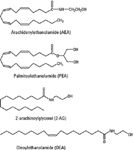Several ZORBAX Rapid Resolution High Definition (RRHD) 1.8 µm Selectivities Facilitate Method Refinement
Agilent Application Note
Anne E. Mack, Agilent Technologies, Wilmington, Delaware, USA.
Introduction
Rapid Resolution High Definition (RRHD) columns, used on UHPLC instruments, provide significant productivity enhancements because they are stable to 1200 bar and can withstand higher flowrates. The Eclipse Plus phase features a double end-capped process and unique bonding that delivers exceptional peak shapes across a broad range of analytes. This makes it an exceptional column for method development. Many users of UHPLC are working with analyses that require the highest level of sensitivity and resolution. Sometimes, alternate C18 phases are desirable because of the additional selectivity refinements they allow.
Endogenous cannabinoids are neurotransmitters that naturally occur in animal organs, especially the brain, and have a role as intercellular messengers similar to the wellknow acetylcholine, gamma aminobutyric acid (GABA), or dopamine. They are quite different, however, because endocannibinoids are lipophilic and found in cell membranes, whereas acetycholine, GABA and dopamine are highly water soluble and are found in the vesicles inside cells.
Anandamide or arachidonoylethanolamide (AEA) was the first endocannabinoid discovered in 1992. Since then, research has shown that these neurotransmitters play significant roles in many life functions, including memory, sleeping and eating patterns and even implantation of the blastocyst (embryonic stage) in the uterus. Structures of anandamide and other endocannabinoids analysed in this application are represented in Figure 1.

Figure 1: Endocannibinoid - related compounds.
Experimental
Four endocannabinoid fatty amides were obtained from Sigma-Aldrich (Bellefonte, Pennsylvania, USA):
- Arachidonoylethanolamide (AEA)
- 2-arachinoylglycerol (2-AG)
- Palmitoylethanolamide (PEA)
- Oleoylethanolamide (OEA)
These were diluted in methanol to a concentration of about 1 to 5 mg/mL each component, then diluted 1:100 in 50% methanol/water for a final sample concentration of 0.01 to 0.05 mg/mL. The 2.1 mm i.d. columns are ideal for electrospray ionization-mass spectrometry (ESI-MS) because low flow-rates (> 1 mL/min) allow for optimal electrospray ionization and introduction to the high-vacuum mass spectrometer.
Long, 100 mm RRHD columns were used for this analysis to further improve efficiency and resolution. The longer RRHD columns coupled with Agilent's 1290 Infinity LC system and high linear velocity flow-rates exploit the system and column's UHPLC pressure limits (1200 bar).
The following Agilent ZORBAX RRHD columns were used:
- Agilent ZORBAX Rapid Resolution High Definition (RRHD) Eclipse Plus C18, 2.1 mm × 100 mm, 1.8 µm, Agilent part number: 959758-902
- Agilent ZORBAX Rapid Resolution High Definition (RRHD) Eclipse XDB-C18, 2.1 mm × 100 mm, 1.8 µm, Agilent part number: 981758-902
- Agilent ZORBAX Rapid Resolution High Definition (RRHD) StableBond SB-C18, 2.1 mm × 100 mm, 1.8 µm, Agilent part number: 858758-902
- Agilent ZORBAX Rapid Resolution High Definition (RRHD) Extend C18, 2.1 mm × 100 mm, 1.8 µm, Agilent part number: 758700-902
The HPLC system used was an Agilent 1290 Infinity LC with an Agilent 6410 triple quadrupole mass spectrometer.
- G4220A binary pump, with mobile phase A: H2O and B: CH3CN, each with 0.1% HCOOH. Analysis was isocratic at 1 mL/min, with varying amounts of CH3CN.
- G4226A automatic liquid sampler (ALS), with injection volume set to 1 µL.
- G1316C thermostatted column compartment (TCC) with temperature set to 30 °C.
- G6410A triple quadrupole mass spectrometer (QQQ), with MS source: electrospray AP-ESI; drying gas temperature and flow: 325 °C, 12 L/min; nebulizer gas pressure: 35 psi; capillary voltage: 3000 V; in MS2Scan mode from 290 to 390. Individual components were monitored at 348, 300, 379, and 326 for AEA< PEA, 2-AG and OEA respectively.
Discussion of Results
The variety of stationary phases available on ZORBAX columns makes them useful for method development, especially for changing selectivity. Having a variety of bonded phases (columns) available to sequentially try in method development analyses demonstrates the different selectivity easily gained from the columns. Figure 2 is an overlay of four different C18 bonded phase available on ZORBAX RRHD 1.8 µm particles. All have a symmetrical peak shape and similar retention. Notice however, that although only four compounds comprise the endocannabinoid sample, a fifth peak is detected. This impurity has a mass of 379, and is believed to be 1,3-arachidonolyglycerol, a rearrangement of 2-AG. This is based on extracted ion MSD data.

Figure 2: The selectivity of four Agilent ZORBAX RRHD C18 columns is compared using a method for endocannabinoids.
The difference in selectivity between the four columns are due to the subtle, yet important differences in bonding, such as the type of bonding, the endcapping or the amount and type of silanols on the silica. Other factors that influence selectivity, including mobile phase composition, temperature and pH, are identical.
These four C18 bonded phases differ slightly, all based on 1.8 µm ZORBAX Rx-SIL silica, though the silica is modified to improve peak shape with the Eclipse Plus C18 column. Each column has its strengths. The Eclipse Plus is the most inert of the four. The Eclipse XDB and the Extend have slightly more silanols and the StableBond has the most exposed silanols. Silanols are often thought to be deleterious but can be used to provide selectivity.
In the full-length app note, available at Agilent.com (pub number 5990-7166EN). Mobile phase composition was varied using the ZORBAX Eclipse Plus RRHD column to evaluate the retention factor of the resolution equation.
Conclusions
The variety of bonded phases available on Agilent ZORBAX 1.8 µm packing adds to the strength of the column's 1200 bar stability. In addition to the four C18 phases described in this work, a variety of other phase are available, or in development, for RRHD columns, making them a flexible, scalable option for pharmaceutical labs that need to ensure method compatibility throughout the development cycle.

Agilent Technologies Inc.
2850 Centerville Road, Wilmington, Delaware 19808, USA
tel. +1 800 227 9770 fax +1 302 633 8901
Website: www.agilent.com/chem/rrhd

Separating Impurities from Oligonucleotides Using Supercritical Fluid Chromatography
February 21st 2025Supercritical fluid chromatography (SFC) has been optimized for the analysis of 5-, 10-, 15-, and 18-mer oligonucleotides (ONs) and evaluated for its effectiveness in separating impurities from ONs.



















